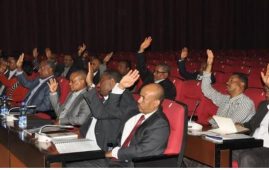Highlight:- "Hailemariam might like to expand his power with time, but there is no sufficient reason to assume that doing so is his primary concern."
In July 2012, when the probability of a post-Meles Ethiopia appeared high, a diplomat based in Addis Ababa pressed me to speculate on prospective successors. I insisted on “Hailemariam Desalegn, or someone like him”.
in Addis Ababa pressed me to speculate on prospective successors. I insisted on “Hailemariam Desalegn, or someone like him”.
The answer did not seem plausible to the diplomat, and she was not alone. Many people, to date, doubt if Prime Minister Hailemariam is up to the job, and primarily because it is uncertain whether he has the skills and personal authority of the late Prime Minister Meles Zenawi.
Judging Hailemariam by Meles’ standards is a common trend. For some, it is simply unavoidable, as the latter is the leader they knew for so long. For others, it seems better to have a powerful helmsman than a sort of collective leadership, in a country where committees are perceived as inefficient and wasteful.
Some went so far as to hypothesize that an authoritative leader is a necessity for the system, and thus Hailemariam is a mere placeholder until the ruling party comes up with a more suitable candidate.
A 100 days after taking oath as Prime Minister, Hailemariam has done little, if anything, to change this perception. In fact, there seems to be more evidence in favour of the ‘placeholder’ hypothesis.
The state media has also been busy glorifying the late Meles, even in its broadcast of Hailemariam’s parliamentary appearance. There is not much effort to build Hailemariam’s image, thus far.
In fact, Hailemariam himself seems to imitate Meles, in more ways than not. and often refers to the latter as “our prime minister” and “our great leader”, in the present tense. But, these cases can be dismissed as temporary moves.
The glorification of Meles could be taken as a tactical move by Hailemariam and his colleagues, in order to maximise the impact of the unexpected public reaction to the passing of the late Prime Minister. Though the great leader narrative seems to undermine the stature of Hailemariam and that of the ruling party, it would have been even riskier to look ungrateful towards their deceased leader, at a time when every noteworthy personality was showering him with praise.
Besides, attempting to scale the contribution of Meles opens up the Pandora’s Box of personality contests among the incumbents, and undermines the impact of the narrative. After all, Hailemariam will have enough time to build his image, once he fortifies the system, ruling under Meles’ shadow, at least for a while. Needless to say, these factors are additions to the ruling party’s tendency to overdo everything.
But this speculation essentially rests on the fallacious assumption that Hailemariam needs to be as authoritative as Meles. The fallacy is taking Meles’ leadership as the rule, rather than the exception.
Indeed, Meles has put the bar for the premiership too high. The breadth of his skill and impact created an impression that finding a successor, means finding a replica of him.
However, history shows that personal attributes of leaders who rule in the formative years of a republic, do not often reappear in their fullest, with regards to their immediate successors. Nor is it much needed in the subsequent period, as could be observed in the era following the long time leaders of Northern and Western European countries.
Moreover, the Ethiopian state was not designed in anticipation of a strong leader, such as Meles. In fact, the contrary is true.
The Ethiopian constitutional arrangement, unlike the British system, provides, what is called, the ‘weak prime minister model’. The Ethiopian Prime Minister can only appoint Ministers, dissolve the parliament and call fresh elections, subject to the approval of the latter. Even the power to establish and restructure executive organs rests with the Cabinet, which, like the Parliament, seeks the endorsement of a coalition, such as the ruling party, which constitutes equal representation of four regional parties and a further six parties orbiting it.
Of course, in spite of this, Meles managed to have great personal clout, through time and historical circumstances, as well as personal skills. But still, there was no move to make that exception the rule.
To the contrary, the ruling party’s leadership replacement (succession) plan, adopted in 2009, sets a two-term limit for the Chairman, and ceils retirement age at 65, for the leadership. As one can hardly join the higher leadership of the ruling party before their mid-40s, there is little chance of accumulating too much power before hitting one of the two limits.
All of these, and several other moves, since 2008, indicate an explicit intent to make the post-Meles leadership a collective one, as he was determined to resign. The promotion of technocrats, Hailemariam included, since then, must have been conducted with this objective in mind.
The recent elevation of two ministers to ranks of deputy prime ministers, to coordinate the executive organs of the state, could also be seen as a natural culmination of what the Party has been progressively experimenting with, in terms of the presidency of regional governments, since 2005.
There is no reason to believe that the Party wishes to depart from this and seek a helmsman for the top post. Nor is it natural for other politicians to resort to that, lest they face existential threats necessitating such.
Indeed, as a politician, Hailemariam might like to expand his power with time, but there is no sufficient reason to assume that doing so is his primary concern.
Hailemariam proved to be a detail oriented and consensus-building leader, suited for the task, in his chairmanship of the Southern Ethiopia People’s Democratic Movement (SEPDM), the southern wing of the EPRDF, which was transformed from a coalition of dozens of ethnic parties into a single collaborative one, on Hailemariam’s watch.
Pioneering a government of technocrats and making collective leadership work at the national level would be an undertaking no less challenging. Living up to that challenge would define Hailemariam’s legacy. Thus, the managerial style of Hailemariam in the past 100 days is likely to remain the norm for the years to come. It might also suffice to keep him in the top seat beyond 2015.
***************
* Originally published on Daniel Berhane’s weekly column "Capital Insight" on Addis-Fortune on January 13, 2013.






Africa Ethiopia
Ethiopia ,africa